
Original Link: https://www.anandtech.com/show/2383
Power Supply Roundup: 730W to 900W
by Christoph Katzer on November 22, 2007 3:00 AM EST- Posted in
- Cases/Cooling/PSUs
Introduction
We recently looked at lower performing power supplies ranging from 400W to 450W. While some of those offerings work well, the reality is that they're not much cheaper to produce than slightly higher rated models, so most of that market is falling to the low quality, budget manufacturers. We return this week to higher performing PSUs rated at 730W to 900W that are more suited for high-end systems running more than one graphics card. It's important to have the proper connectors - and a sufficient quantity of connectors - along with a good distribution of power across the rails. Nobody running a higher end system enjoys crashes in the middle of a gaming session, after all. We have quite a few models to test from several companies, including four 850W PSUs.
Also included is one model that officially only supports a 200VAC to 240VAC input. This PSU is for the European market, but we still found it very interesting. We are talking about the Seasonic X900, but Seasonic also serves as the ODM for other brands, several of which we have reviewed. Whether or not the Seasonic X900 shows up in the US under that name, we will almost certainly see it in some form.
Note: If you would like to know more about our testing methodology, equipment, and environment, please read our PSU testing overview.
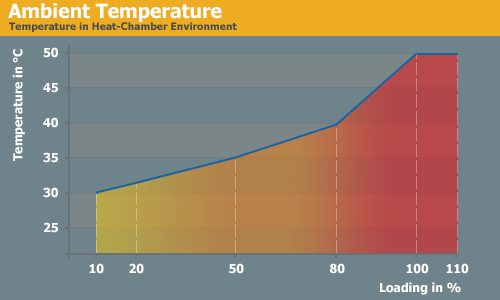
As previously stated, we now test with an additional 10% load beyond the rated output to see how the units cope with overload situations. We begin overload testing at room temperature, and if everything checks out we move on to our stress testing "heat chamber" that tops out at 50°C. Experience indicates that while many units can stand the overload testing at room temperature, others will have difficulty with the higher temperature and overload combined. Only the top units will survive this torture test.
We're going to change the order or presentation and begin with the results first, followed by pictures and discussions of the individual units. We will sort the products according to their rated output rather than name so that similar units are in close proximity to each other.
Product Comparison - Loading Charts
Amacrox Freesstyle 750
|
PSU Load |
3.3V |
5V |
12V1 |
12V2 |
12V3 |
12V4 |
Wattage All Rails |
|
10% |
1.80A |
1.80A |
1.29A |
1.29A |
1.29A |
1.29A |
80W |
|
20% |
3.59A |
3.59A |
2.58A |
2.58A |
2.58A |
2.58A |
157W |
|
50% |
8.99A |
8.99A |
6.44A |
6.44A |
6.44A |
6.44A |
390W |
|
80% |
14.38A |
14.38A |
10.30A |
10.30A |
10.30A |
10.30A |
617W |
|
100% |
17.97A |
17.97A |
12.88A |
12.88A |
12.88A |
12.88A |
762W |
|
110% |
19.77A |
19.77A |
14.16A |
14.16A |
14.16A |
14.16A |
834W |
Antec Truepower Quattro 850
|
PSU Load |
3.3V |
5V |
12V1 |
12V2 |
12V3 |
12V4 |
Wattage All Rails |
|
10% |
1.71A |
2.05A |
1.41A |
1.41A |
1.41A |
1.41A |
86W |
|
20% |
3.42A |
4.10A |
2.82A |
2.82A |
2.82A |
2.82A |
171W |
|
50% |
8.54A |
10.25A |
7.06A |
7.06A |
7.06A |
7.06A |
424W |
|
80% |
13.67A |
16.40A |
11.30A |
11.30A |
11.30A |
11.30A |
670W |
|
100% |
17.08A |
20.50A |
14.12A |
14.12A |
14.12A |
14.12A |
830W |
|
110% |
18.79A |
22.55A |
15.53A |
15.53A |
15.53A |
15.53A |
908W |
Cooler Master Real Power M850
|
PSU Load |
3.3V |
5V |
12V1 |
12V2 |
12V3 |
12V4 |
12V5 |
12V6 |
Wattage All Rails |
|
10% |
1.79A |
2.15A |
0.78A |
0.78A |
1.22A |
1.22A |
0.78A |
0.78A |
78W |
|
20% |
3.58A |
4.29A |
1.57A |
1.57A |
2.44A |
2.44A |
1.57A |
1.57A |
172W |
|
50% |
8.94A |
10.73A |
3.92A |
3.92A |
6.09A |
6.09A |
3.92A |
3.92A |
426W |
|
80% |
14.30A |
17.16A |
6.27A |
6.27A |
9.75A |
9.75A |
6.27A |
6.27A |
674W |
|
100% |
17.88A |
21.45A |
7.83A |
7.83A |
12.19A |
12.19A |
7.83A |
7.83A |
835W |
|
110% |
19.66A |
23.60A |
8.62A |
8.62A |
13.41A |
13.41A |
8.62A |
8.62A |
915W |
Hiper Type M Mk II 730 (HPU-5M730)
|
PSU Load |
3.3V |
5V |
12V1 |
12V2 |
12V3 |
12V4 |
Wattage All Rails |
|
10% |
1.56A |
1.87A |
1.19A |
1.19A |
1.19A |
1.19A |
74W |
|
20% |
3.11A |
3.74A |
2.39A |
2.39A |
2.39A |
2.39A |
148W |
|
50% |
7.79A |
9.34A |
5.96A |
5.96A |
5.96A |
5.96A |
368W |
|
80% |
12.46A |
14.95A |
9.54A |
9.54A |
9.54A |
9.54A |
584W |
|
100% |
15.57A |
18.68A |
11.93A |
11.93A |
11.93A |
11.93A |
725W |
|
110% |
17.13A |
20.55A |
13.12A |
13.12A |
13.12A |
13.12A |
795W |
Hiper Type R Mk II 770 (HPU-5K770)
|
PSU Load |
3.3V |
5V |
12V1 |
12V2 |
12V3 |
12V4 |
Wattage All Rails |
|
10% |
1.56A |
1.87A |
1.24A |
1.24A |
1.24A |
1.39A |
78W |
|
20% |
3.11A |
3.74A |
2.48A |
2.48A |
2.48A |
2.78A |
156W |
|
50% |
7.79A |
9.34A |
6.19A |
6.19A |
6.19A |
6.96A |
387W |
|
80% |
12.46A |
14.95A |
9.90A |
9.90A |
9.90A |
11.14A |
612W |
|
100% |
15.57A |
18.68A |
12.38A |
12.38A |
12.38A |
13.92A |
760W |
|
110% |
17.13A |
20.55A |
13.61A |
13.61A |
13.61A |
15.31A |
833W |
Hiper Type R Mk II 880 (HPU-5K880) & Type M 880 (HPU-4M880)
|
PSU Load |
3.3V |
5V |
12V1 |
12V2 |
12V3 |
12V4 |
Wattage All Rails |
|
10% |
1.98A |
1.98A |
1.10A |
1.10A |
1.83A |
1.83A |
88W |
|
20% |
3.96A |
3.96A |
2.19A |
2.19A |
3.66A |
3.66A |
176W |
|
50% |
9.91A |
9.91A |
5.48A |
5.48A |
9.14A |
9.14A |
436W |
|
80% |
15.85A |
15.85A |
8.77A |
8.77A |
14.62A |
14.62A |
692W |
|
100% |
19.82A |
19.82A |
10.97A |
10.97A |
18.28A |
18.28A |
853W |
|
110% |
21.80A |
21.80A |
12.06A |
12.06A |
20.10A |
20.10A |
934W |
OCZ ModXStream 780
|
PSU Load |
3.3V |
5V |
12V1 |
12V2 |
12V3 |
12V4 |
Wattage All Rails |
|
10% |
2.09A |
2.09A |
1.24A |
1.24A |
1.24A |
1.24A |
80W |
|
20% |
4.18A |
4.18A |
2.48A |
2.48A |
2.48A |
2.48A |
161W |
|
50% |
10.45A |
10.45A |
6.19A |
6.19A |
6.19A |
6.19A |
398W |
|
80% |
16.72A |
16.72A |
9.91A |
9.91A |
9.91A |
9.91A |
629W |
|
100% |
20.90A |
20.90A |
12.39A |
12.39A |
12.39A |
12.39A |
780W |
|
110% |
22.99A |
22.99A |
13.63A |
13.63A |
13.63A |
13.63A |
854W |
Seasonic X900
|
PSU Load |
3.3V |
5V |
12V1 |
12V2 |
12V3 |
12V4 |
Wattage All Rails |
|
10% |
1.53A |
1.91A |
1.54A |
1.54A |
1.54A |
1.54A |
90W |
|
20% |
3.05A |
3.82A |
3.09A |
3.09A |
3.09A |
3.09A |
180W |
|
50% |
7.64A |
9.55A |
7.72A |
7.72A |
7.72A |
7.72A |
444W |
|
80% |
12.22A |
15.27A |
12.35A |
12.35A |
12.35A |
12.35A |
701W |
|
100% |
15.27A |
19.09A |
15.44A |
15.44A |
15.44A |
15.44A |
869W |
|
110% |
16.80A |
21.00A |
16.99A |
16.99A |
16.99A |
16.99A |
951W |
Silverstone OP850
|
PSU Load |
3.3V |
5V |
12V1 |
Wattage All Rails |
|
10% |
1.70A |
1.82A |
5.72A |
85W |
|
20% |
3.40A |
3.64A |
11.44A |
170W |
|
50% |
8.50A |
9.10A |
28.61A |
421W |
|
80% |
13.59A |
14.57A |
45.77A |
667W |
|
100% |
16.99A |
18.21A |
57.21A |
826W |
|
110% |
18.69A |
20.03A |
62.93A |
905W |
Product Comparison - Cable Length
As you can see below, we have a new cable length comparison chart now. This should make it easier to compare the various PSUs with all of the test units in each roundup appearing in each chart. We will have multiple images for the various connector types to keep things manageable. We've color coded the background from red to green as an indication of how well the cables will work in full-size towers. Naturally, if you have a smaller case and prefer not to have extra cable snaked into the crannies, you might prefer a PSU with shorter cables.
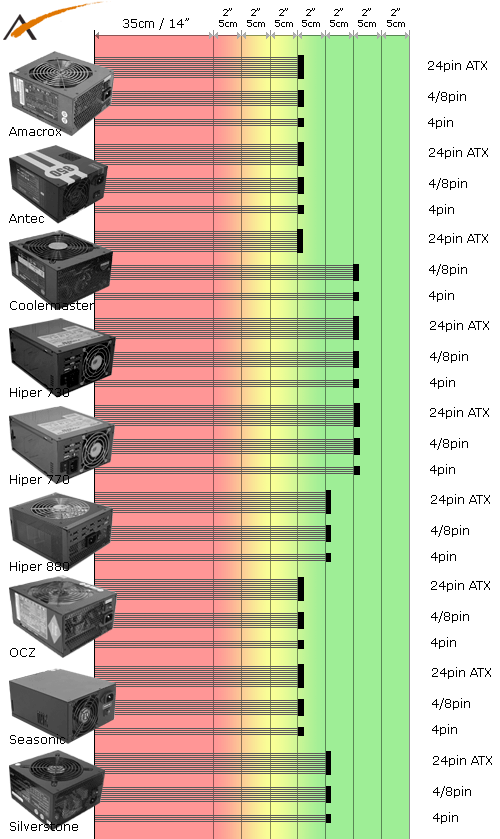
All of the test units in this roundup have a minimum length of 50cm on all harnesses, making them a good match for larger cases. Hiper and Cooler Master have slightly longer cables on some or all of the ATX harnesses, with a length of 60cm or 24".
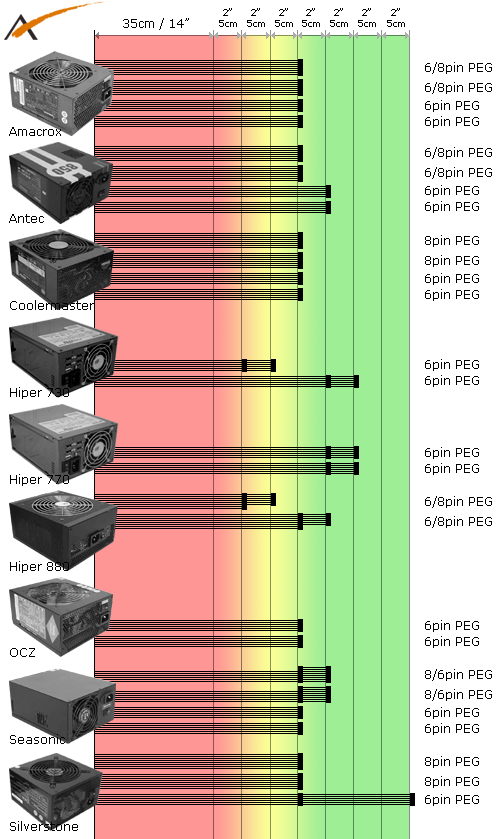
The graphics power connectors (also called PEG connectors) present a very different approach from the companies. Hiper includes one long and one shorter harness, which make sense as the two graphics cards are above each other and therefore you won't need the same length for both of the harnesses. Unfortunately, the 730 and 770W models don't include any 8-pin PEG connectors.
The 880W unit has two harnesses with two connectors each. The first one is an 8-pin connector and the second is a 6-pin. The problem with this approach is the amount of power delivered on the individual wires. If the user attaches both connectors to a demanding GPU, you end up with a potential for 225W to come across a single rail - potentially enough to cause problems, though testing proceeded without incident. While no current graphics cards require this much power, a modified design would be appreciated.
Seasonic also has an odd design. Their PEG harness only has six cables, but they still utilize an 8-pin PEG connector at the end. Two of the wires serve double duty and connect to two pins, but ideally and 8-pin PEG connector would have eight wires from the PSU. Whether these cables are a higher gauge in order to deal with the additional demands is not clear, but again testing proceeded without any noticeable difficulties.
All the other units have real 8-pin PEG connectors to power up the latest graphics cards. Silverstone wins the longest 6-pin cable competition with their 70cm/28" harness, though the other three connectors are a more modest 50cm length.
Product Comparison - DC Outputs
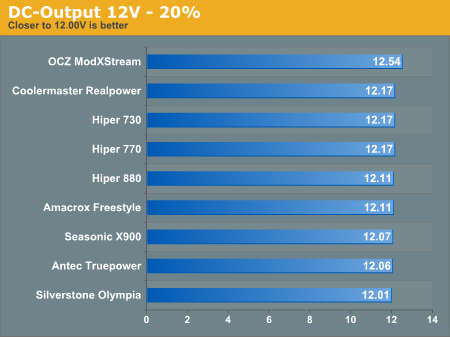
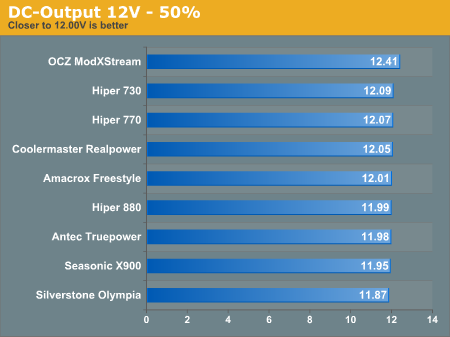
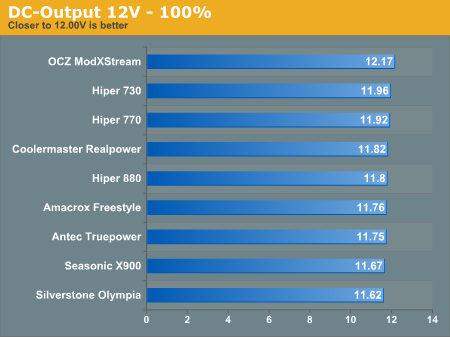
To provide a better overview, we have averaged the results of the separate 12V rails into line for each PSU. All of the 12V rails were stable during testing and we didn't experience any major problems. The 12V rails of the OCZ ModXStream tended to be high, but this is still acceptable as they fall inside the specified range.
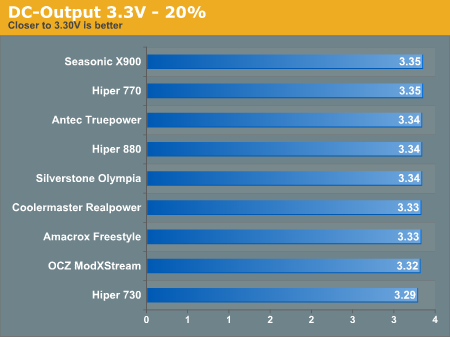
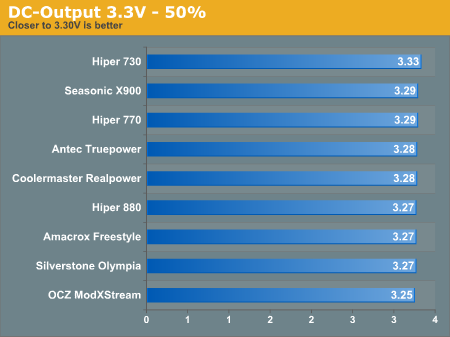
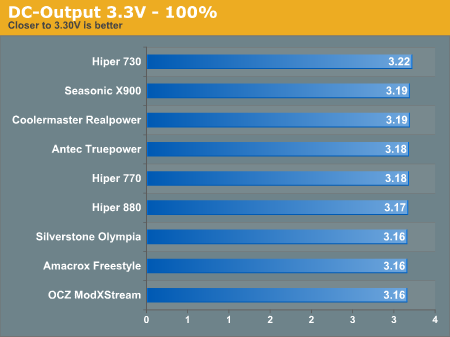
The 3.3V rails are equally good and we only see minor flaws at higher loads from most of the units.
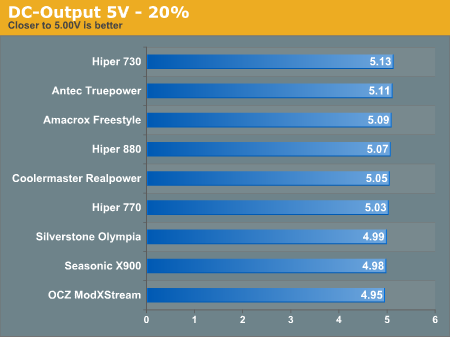
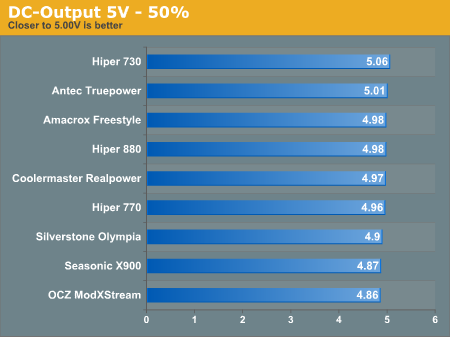
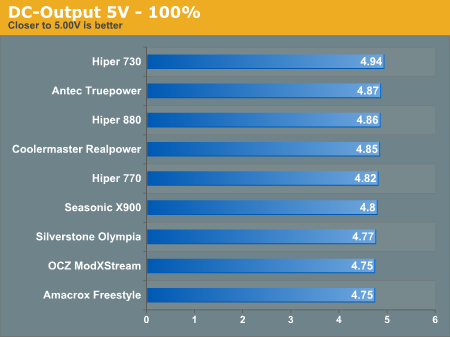
The 5V rails also remain within specs, but the last two units (OCZ and Amacrox) are very close to the lower boundary at 100% load.
Voltage Ripple and Noise
Amacrox
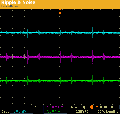 |
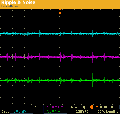 |
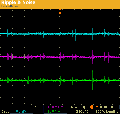 |
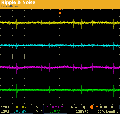 |
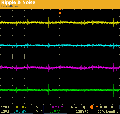 |
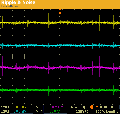 |
Antec
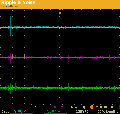 |
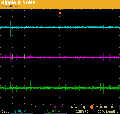 |
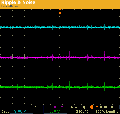 |
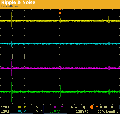 |
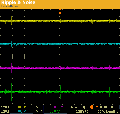 |
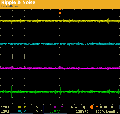 |
Cooler Master
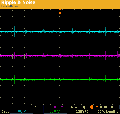 |
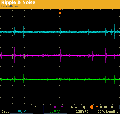 |
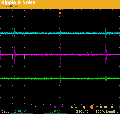 |
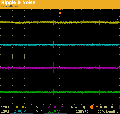 |
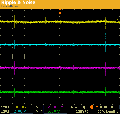 |
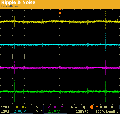 |
Hiper 730
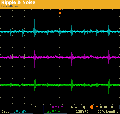 |
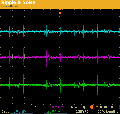 |
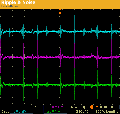 |
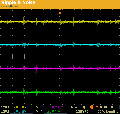 |
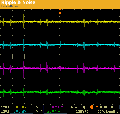 |
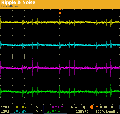 |
Hiper 880
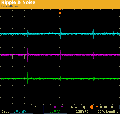 |
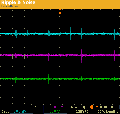 |
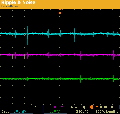 |
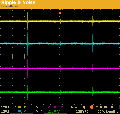 |
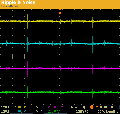 |
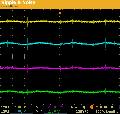 |
OCZ
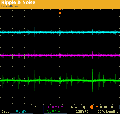 |
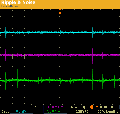 |
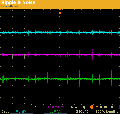 |
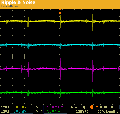 |
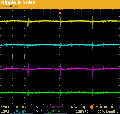 |
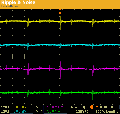 |
Seasonic
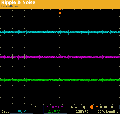 |
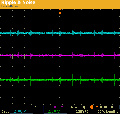 |
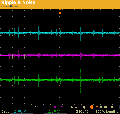 |
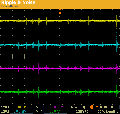 |
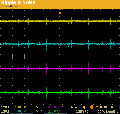 |
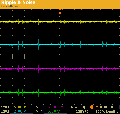 |
Silverstone
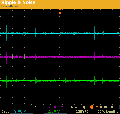 |
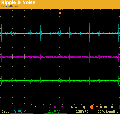 |
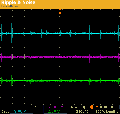 |
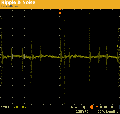 |
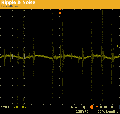 |
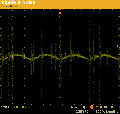 |
None of the units exhibit very high ripple noise, though we still see differences. Amacrox in particular generates a good results with just up to 30mV on the 5vsb rail and less than 10mV on all others. Unfortunately, we can't report results for the Hiper 770W unit since we took it apart for further inspection before we could perform the o-scope tests. The other three units performed quite well and the 730W version in particular delivers no more than 8mV on the various rails.
Antec shows minor problems on the 5Vsb rail as well since it goes slightly out of spec, but the other rails are within spec. The Cooler Master M850 is good on the 12V rails, though 12V2 and V3 are showing strangely high results of up to 80mV. OCZ also shows minor flaws on most of the rails where we see peaks up to 80mV at higher load. This might sound high but it's still within specs and not much to worry about. Seasonic could perform better, since the results for the X900 are not worthy of a high-end unit like this. Throughout the test the X900 generated ripple of up to 40mV on the 5V rail, and the 12V rails don't look much better. Finally, at maximum load the Silverstone OP850 shows 36mV on the single 12V rail and also high ripple on the lower 3.3V and 5V rails.
Product Comparison - Efficiency
We have color-coded the background graphic to represent four classes of PSU. Category one is in the green and represents small to medium systems with a single lower power graphics card. The yellow range is for systems with a single graphics card, though possibly one of the more demanding models, as well as systems with a more powerful CPU (quad-core) and potentially more than one hard drive. The orange background is for systems with two graphics cards, possibly with a quad-core processor as well. Finally, we have the red category which is frankly very difficult to reach with normal home computers at the moment; serious overclocking, quad-core, and multiple GPUs can require this sort of power supply. This background will be used in future comparisons as well, and with the wattage figures as the X axis users will be better able to choose a power supply that offers high efficiency in the desired range.
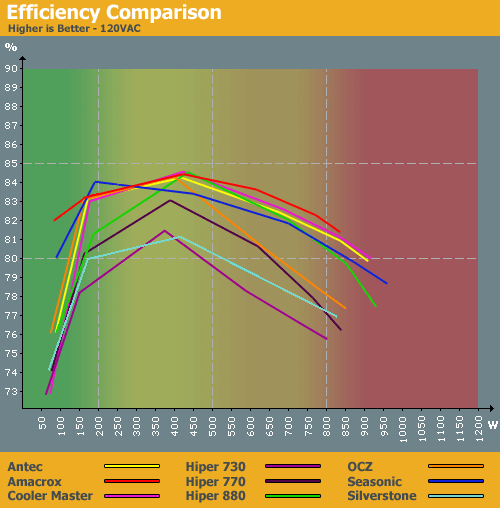
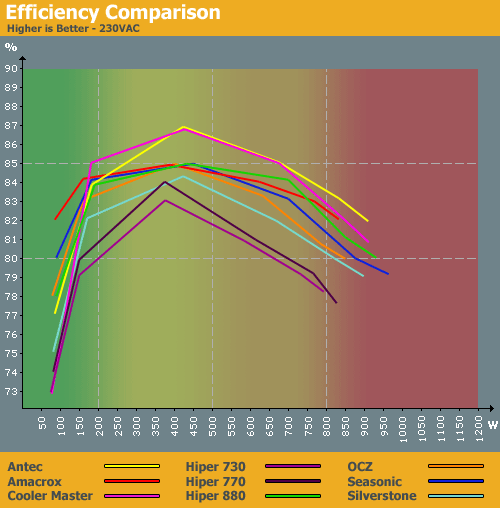
Obviously, if you are running a normal setup with a single graphics card you will not need any of the units we're testing today. If you are using a typical dual-core CPU with a moderate graphics card (without overclocking), you will not need a power supply with more than 400W max output. Your system will likely draw 75W-125W in idle mode (perhaps slightly less), and with higher-end power supplies like what we're testing today you would get a relatively low efficiency rating. Only systems that are regularly using more than 200W should even consider these 730W and higher power supplies.
The two units with the best efficiency results today are the Antec and Cooler Master models, which are both manufactured by the same ODM. Many of the other models show similar results, reaching near 85% efficiency. The OCZ ModXStream 850W and the Hiper 730W and 770W take the bottom three curves at 120VAC; the Silverstone unit is also near the bottom on the 230VAC chart.
Product Comparison - Acoustics
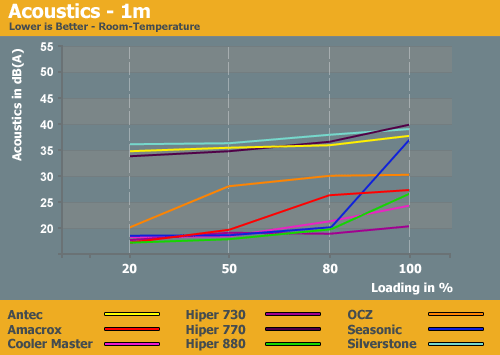
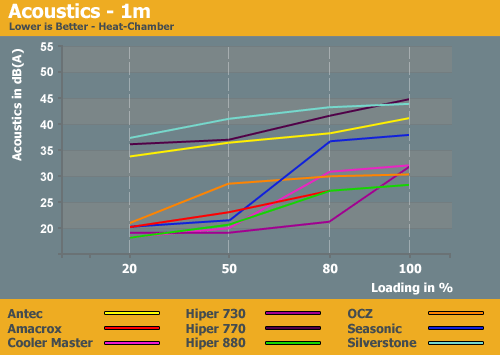
The acoustics graphs tell a very clear story: three of the units have higher noise levels than the others throughout the test. The Antec TruePower Quattro, Hiper Type-R 770 Mk II, and Silverstone Olympia have the noisiest fans within this group of high-end power supplies. Even at lower loads, the fan speeds are quite high, resulting in the higher noise levels. All the remaining units perform well as the graphs show. During room temperature testing, most of the units stay under 20dB(A) up to around 80% load, at which point the fans need to work harder to cool the insides down.
Seasonic uses a very strict fan control scheme, which attempts to leave the fan running at lower speeds as long as possible. It's only when temperatures reach critical levels that the fan speed kicks up, and even then noise only increases by around 15dB(A). Two of the Hiper units also generate good results; both 880W models (shown with a green curve) stick out from the rest with low noise results. Even higher ambient temperatures don't disturb them much, as the temperature reaches about 76°C which is a normal result.
Prices and Conclusion
All the power supplies seen today perform well under normal conditions, though Amacrox showed us why we actually test under stress conditions like the heat chamber. This is in fact the first broken power supply we've encountered since we started reviewing PSUs this year; frankly, we're surprised it took this long. The cause of the failure is most likely a broken Schottky diode, but our investigation is ongoing.
Though the power supplies have different max outputs, they can be regarded as one group serving the high-end market. These are power supplies for people running more than one graphics card and multi-core CPUs, probably with some moderate overclocking as well. After looking at the test results, we like the Cooler Master M850 and Antec TruePower Quattro 850 the most. They are reliable and have very stable DC outputs. They also generate the highest efficiency scores of the group with up to 87% at a medium load of 400W (with 230VAC). However, the ripple results could be better, and from in terms of noise the Cooler Master performs better than the Antec unit.
At the end of the day, it often comes down to price - perhaps the most important factor for many buyers. While a PSU may perform incredibly well, if the price is too high many will opt for a cheaper competitor. We'll look at prices in both $USD and EUR.
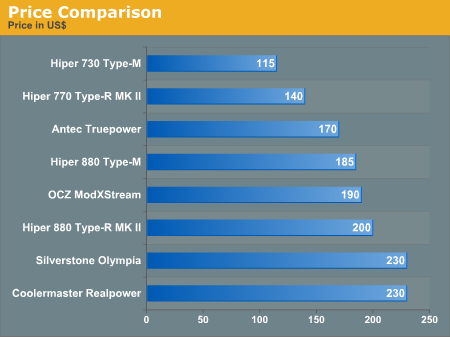
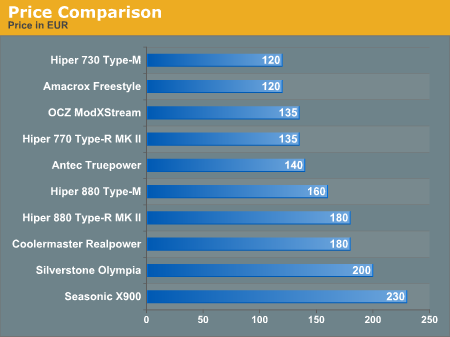
Some of the units are currently not available in the US, so we'll omit them from the $USD comparison. The Seasonic X900 is a very nice power supply, but we have to recommend looking at other previously tested models. You are far better off with the PC Power & Cooling Silencer 750 QUAD for a lower price and equal or better performance. Silverstone's Olympia is also too expensive right now, and given the performance in our tests we cannot give it a recommendation.
We mentioned Cooler Master and Antec already, as both generated good results. The price difference is quite large, and even though the Cooler Master performed slightly better we recommend the Antec TruePower Quattro since it's available for 140 EUR and $170 USD. At around 145 EUR or $200 USD the OCZ ModXStream places in the middle of the group, but despite reasonable performance we can't see much reason to buy an OCZ as opposed to the less expensive Antec TruePower Quattro.
Hiper targets the low to medium price regions. All of the units turned in a good performance today, and for the price we can certainly recommend them. Just pay attention to the available connectors, as we saw some important differences there.
Given the fact that the EUR to $USD exchange rate is quite high at the moment, all of the power supplies look like quite a bargain in the US. If you'd like to read more details of the individual power supplies, the remaining pages will provide pictures of the internals and additional commentary.
Amacrox Freestyle - 750W
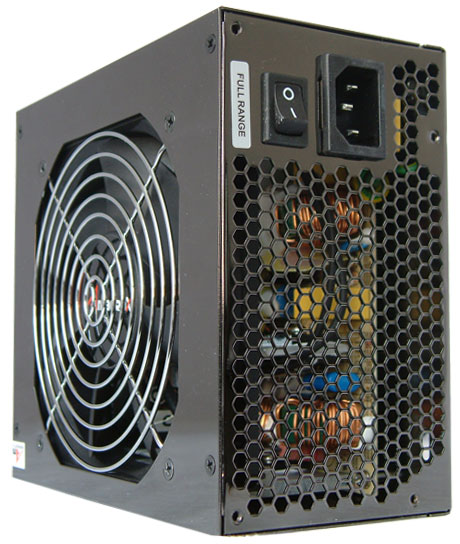
Amacrox is well known in the European market, providing good quality at an affordable price. The ODM (Original Design Manufacturer) is FSP, also known as Fotron Source - one of the five largest power supply manufacturers in the world. Amacrox is one of several retail brands FPS uses. The Freestyle 750 has a shiny appearance and contains a 12cm fan on the bottom of the power supply. The packaging is quite nice and gives potential buyers a good view of the power supply in retail shops, since there is a small window that allows a look at the power supply inside. Besides the standard short manual, the box also includes a bag in which you can store unused cables.
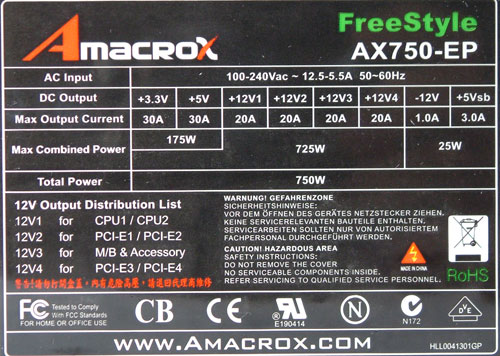
We find four 12V rails rated at 20A each, and a combined power of 725W. The 3.3V and 5V rails both provide 30A. The description Amacrox provides about which connectors are powered by the various 12V rails is a nice addition. 12V1 is connected to both of the CPU connectors in form of the 4-pin and 8-pin and ATX connectors, 12V2 handles the first two graphics cards, and 12V3 is for peripherals such as hard disks and optical drives as well as the motherboard. The 12V4 rail keeps the next round of graphics cards running.
Cables and Connectors
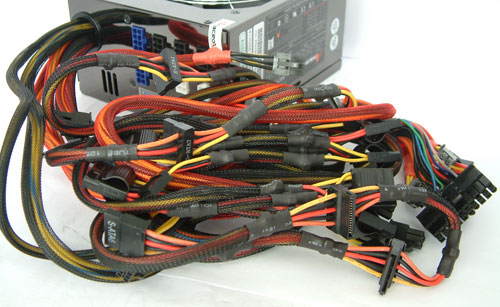
All cables are sleeved, with the PCI-E harnesses in orange color instead black. There are several other differences between this PSU and the other units. Amacrox has more SATA than Molex connectors attached while other manufacturers take the reverse approach. The two 6-pin and 6/8-pin PEG connectors (four total) on the 750W unit provide enough power for most graphics configurations.
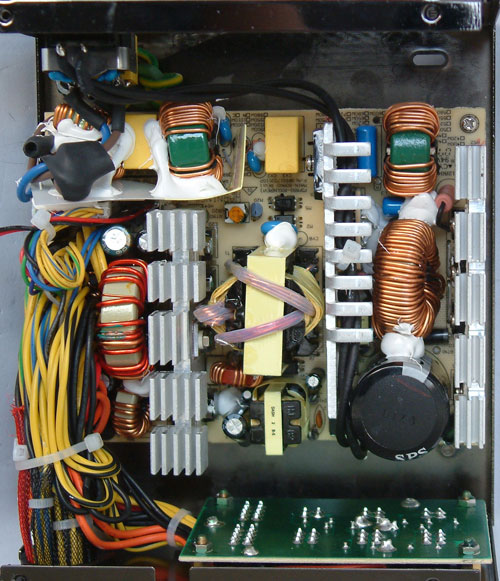
Opening the unit reveals a standard FSP topology with three heatsinks. FSP uses components that won't generate too much heat, which also results in a better efficiency. The heatsinks can therefore be a little thinner and not quite as large/heavy. We'll see a similar approach in the Seasonic power supply. The Taiwan Oster Corporation manufactures the primary cap, and it seems to be a cheaper offering than what we'll see elsewhere. The secondary side uses capacitors from CapXon.
Antec TruePower Quattro - 850W
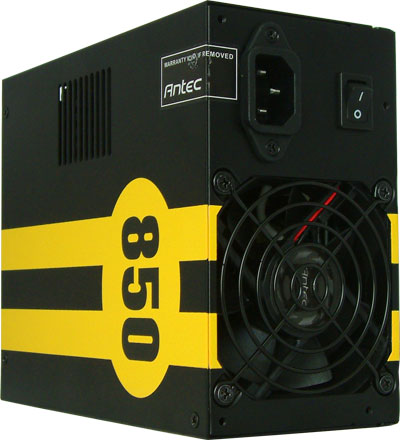
The Quattro 850 has a very difference appearance than other offerings. Antec painted yellow racing stripes on the black housing, which gives it a unique appearance. Whether that's good or bad is up to personal opinion; regardless, you won't see these stripes when the power supply is mounted in most cases. The cooling is provided by an 80mm fan located at the front of the power supply. The packaging is well built, providing protection during transportation. We found all the standard accessories in the box.
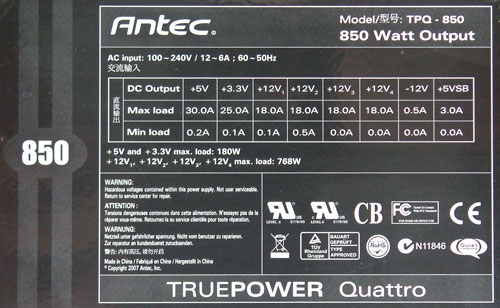
The label shows four 12V rails rated at 18A each. The lower voltage 3.3V and 5V rails have the standard 25A and 30A rating, respectively, which is more than enough in today's systems. The total maximum load for the 12V rails is described as 768W, which is good for demanding systems. Antec lists 100-240VAC input voltage on the label, but as with other units we tested the Antec with 90VAC as well and didn't encounter any problems.
Cables and Connectors
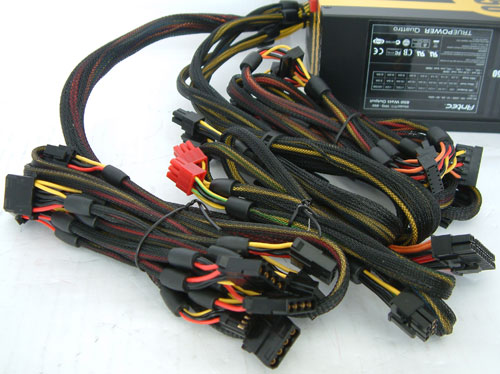
All cables are sleeved with a black mesh; this looks pretty but naturally increases the price. For an 850W power supply the TruePower Quattro has one of the highest amounts of cable harnesses. There are nine Molex and eight SATA connectors, which could power up quite a lot of hard drives. Of course, looking at the back of the power supply we see only three jacks for peripherals; the user can only attach three of the harnesses, but at least they can choose which cables they need.
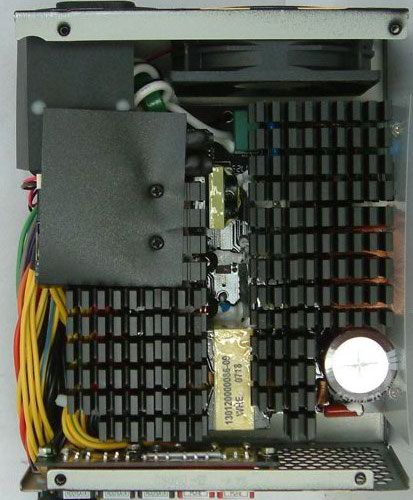
Two massive heatsinks occupy most of the internal space; these are not only wide but also thick. This arrangement keeps the inside cool and we measured only up to 68°C with 50°C ambient temperature outside of the power supply. Heat is transferred quickly out of the power supply and the heatsinks leave plenty of space for air to cool the components on the PCB.
Antec uses quality components, with a Nippon Chemi-Con capacitor rated at 470µF, 450V, and 105°C taking center stage. The secondary side has several Teapo caps installed, which is a common choice. Overall, the topology makes a very good impression.
Cooler Master M850 - 850W
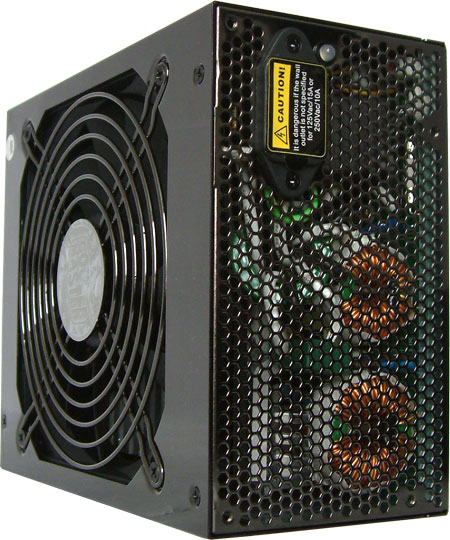
Cooler Master sent its high-end M850 power supply, which comes with a shiny mirror finish paintjob. A large 135mm fan on the bottom is responsible for cooling. There are plenty of holes at the back to serve as an exhaust. The unit lacks a power switch, which might be a concern for some people; however, since most people use power strips for their computer and peripherals this shouldn't be a major problem. The sticker on the AC jack was unnecessary, and the residue it left after removal is something we could have done without. Next to the jack is a small LED that indicates the status of the power supply. During our high temperature stress tests, the lamp glowed red the whole time; however, the PSU still worked fine as we can see from the results.
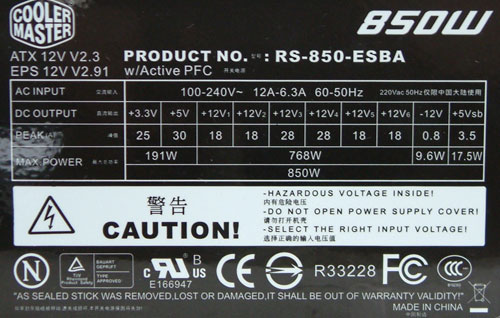
The label shows a total of six 12V rails which are rated at 18A (four) and 28A (two); however, the combined power is only 768W. This means there is around 10A per rail with combined power. This approach of writing whatever seems convenient on the label is a new trend, as though the manufacturers want to show there's no need to worry about power requirements. Incidentally, the 1000W version of this power supply has the same ratings for its 12V rails; the only difference is a higher combined power. The only way to manage this is with OCP. With six rails - and especially with two rails rated much higher than the others - it would have been great if Cooler Master listed the exact power distribution in the manual. They have provided this information for the 24-pin, 4-pin, and 8-pin ATX connectors, but not for the equally important graphics cards connectors.
Cables and Connectors
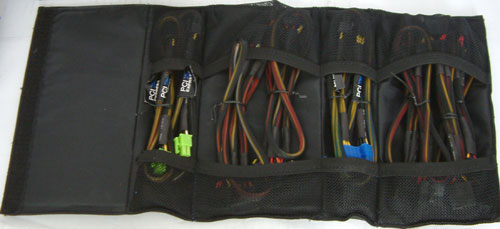
The cables are delivered in a nice, sleek bag that can be folded up. The cables are waiting patiently to come out and play. All are sleeved and the 6/8-pin PEG connectors differ in color. With ten Molex and eight SATA connectors the Cooler Master M850 is well equipped, and the length of up to 90cm is good for larger cases.
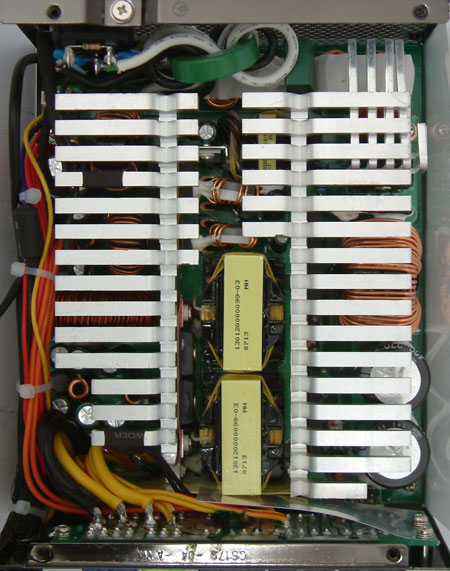
Looking inside will make any electronics enthusiast's heart beat faster. It's just a beautiful arrangement, and the two transformers will offer a great deal of power distribution. The primary side has a huge coil with two capacitors made by Nippon Chemi-Con and rated at 420V, 270µF, and 85°C (each). The secondary caps are made by Teapo. The soldering on the PCB for the cable management could be nicer, but the rest of the inside looks very clean. The heatsinks are well sized and thick. They are able to take a lot of heat from the attached components, and the space between the fins leaves enough room for air to reach the components on the PCB. Temperature diodes attach to the secondary heatsink on both sides - the two shrinking hoses where they attach to the fins are visible.
Hiper 5M730 and 5K770 - 730 and 770W
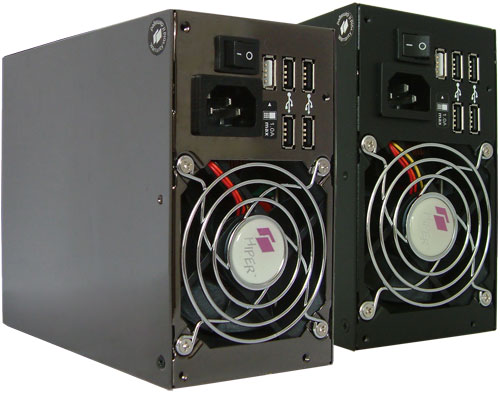
With the Type-R MK II series we have the first units from the British brand Hiper - which stands for "High Performance Group" if you were wondering in test at Anandtech. Hiper has been around for a long time and has a large variety of products in their portfolio. Power supplies are what we will be looking at today. We received several different models, and we'll start with the 730W version.
Hiper frequently comes up with new ideas that have helped make them famous, and that's why we weren't surprised to see USB ports on the back of this unit. We have not seen that before, and having five more USB ports on the back of your computer will certainly please some users. If a couple front USB ports aren't enough, the Hiper provides four additional "normal" ports, plus one port that works when the PC is switched off to load devices like a Blackberry for example.
Hiper packs everything in a plastic box that can be used for other things after the PSU is removed. A layer of foam protects the power supply from vibration during transportation. There are a lot of additional cables and accessories in the box. The unit has a shiny mirror finish that likes to collect fingerprints. Again, whether or not that's important will be up to the individual - it seems to need frequent cleaning, and it's much easier to scratch. Still, some people might appreciate the extra "bling".
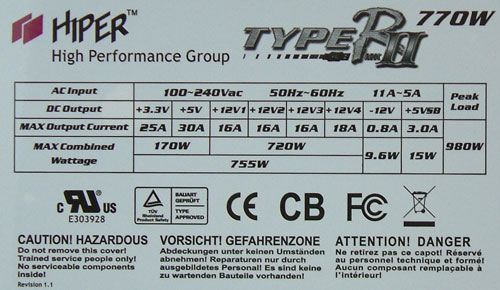
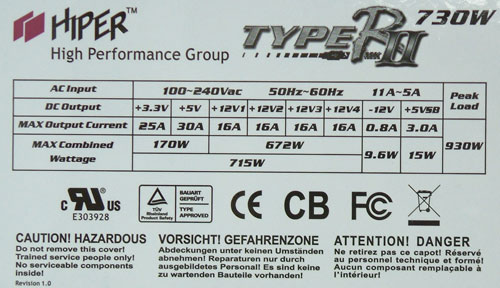
The cooling is provided by an 80mm fan at the front of the unit. This will have to be a very strong fan since there is only one and the inside isn't very conducive to airflow. The unit can be powered from the standard 100VAC to 240VAC; why this needs to be written next to the power jack is a mystery. Above the power jack are the USB ports, and the single white port will provide power even when the PC is off. The labels indicate that the two units are not very different, and in fact it's only the 12V rails that are rated higher on the 770W model. The only difference inside will be a few lower rated capacitors in the 730W unit.
Cables and Connectors
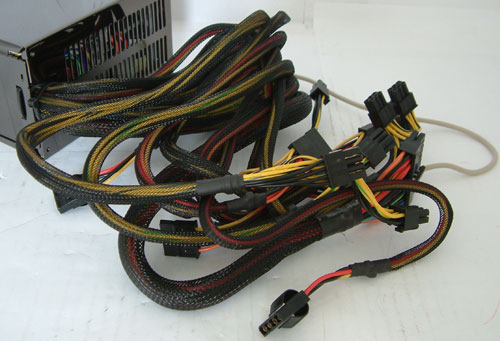
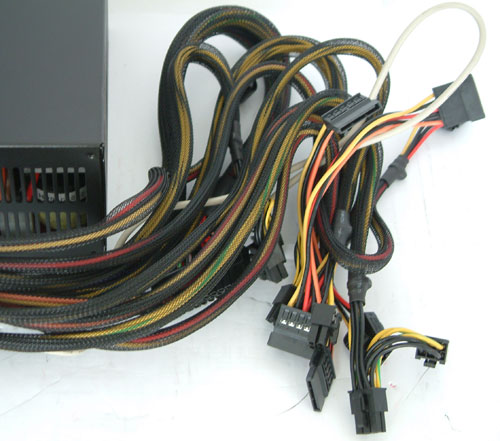
The backside is wide and open to help with airflow, and we can already see the complexity that waits to greet us inside. All the cables are sleeved with a black mesh which is pretty standard for high-end power supplies. The minimum lengths of the main cable harnesses are 60cm which is longer than normal. There are four 6-pin PEG connectors, but no 8-pin PEG. There are two PEG connectors on each cable harness, which means if both connectors are used on high-end GPUs all of the power will go through only three 18AWG cables. In that case the cables will get pretty warm. It's better to have each connector on a separate harness, since then each connector has its own power and ground cables. For midrange graphics cards this is not an issue, and without the missing 8-pin PEG connector it's doubtful that you will be able to power the top-end GPUs (or at least the most power hungry offerings) anyway.
There are not many cable harnesses for SATA and Molex, which is odd for 730W/770W PSUs. There are only four SATA connectors on two harnesses, and three Molex connectors on one cable. At least the Molex connectors can get help from splitters, but four SATA connectors could prove limiting in the future. The splitter approach isn't good either, as each additional connection creates increased internal resistance. It would be better for Hiper to include additional connectors, consider the PSU ratings.
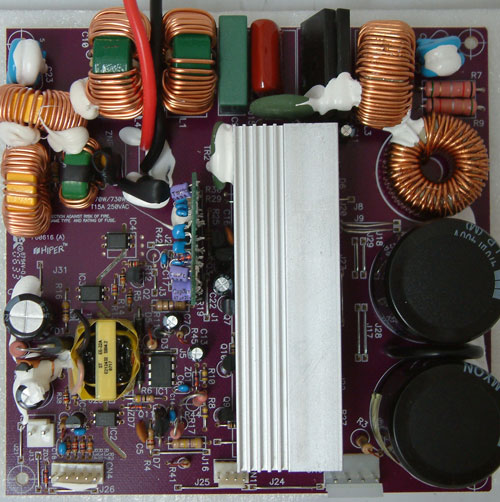
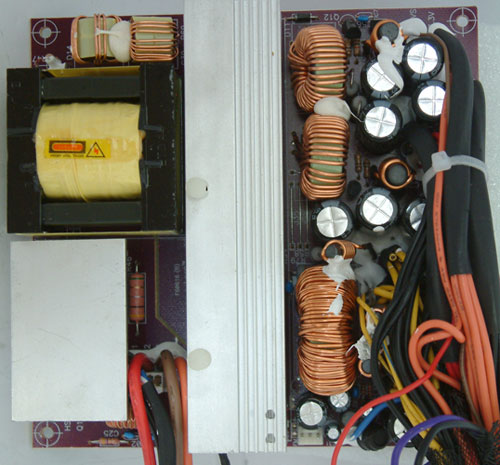
Unfortunately for us, it's almost impossible to get this power supply open without either destroying it or at least damaging some components. If that was the intended result to keep reviewers and consumers from poking around, well done - you succeeded. Once open, we found a decent build quality that is well arranged, albeit unconventional. There are two PCBs inside of the unit which are facing each other (with the PCB on the outside). The air passes through the middle and cools both heatsinks. For this arrangement all the components can only be half the height of a normal power supply.
The filtering stage is located at the front and occupies parts of the right side as well. Under the red and black cable is the standby circuit. Beside the left heatsink we have the PFC IC and on the far right side we see the two main caps which are manufactured by Samxon and rated with at 470 µF and 400V each. Most of the other components like rectifier bridges and diodes come from Fairchild.
Hiper 4M880 and 5X880 - 880W
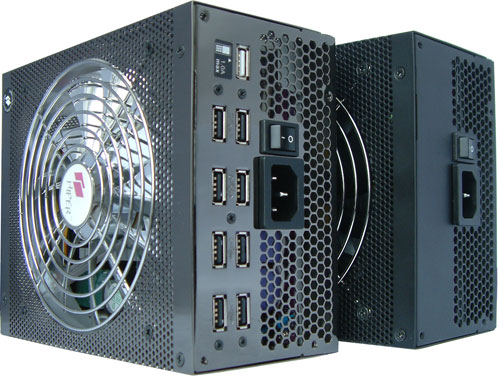
The second series of Hiper today comes with a different design and a different internal topology. The 5X includes eight USB ports and an additional port that can support up to 1A while the PC is off. This PSU also comes in a nice, shiny paintjob. Due to the USB ports on the back, the venting holes only occupy the upper section.
The 4M has no USB ports and a has normal black matte coating, but the space where the USB ports would have been located is still closed. Hiper started the idea of keeping the housing open with a mesh a long time ago. This idea has pros and cons since we might have increased problems with EMI and the airflow could also recycle back into the system. During our tests we couldn't answer the EMI question since we lack the proper equipment, but we might be able to help out with the venting issue since we didn't find any negative temperature results with the actual design.
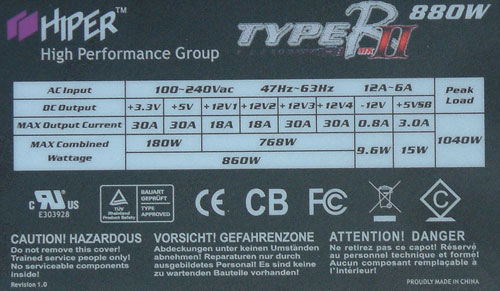
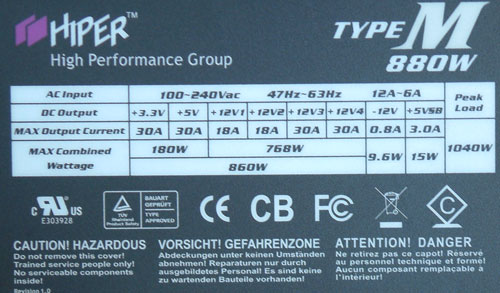
Both units are the same inside and therefore we see the same data on the labels. The first two 12V rails are rated at 18A and the second two rails at 30A. The both 30A rails will be powering the graphics card PEG connectors, which makes sense.
Cables and Connectors
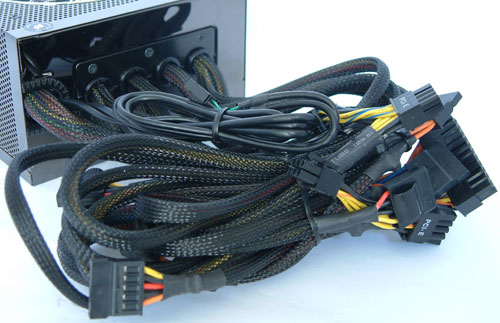
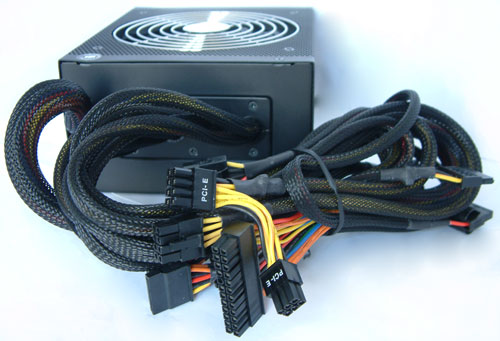
The cable harnesses look nice and sleek, and we see a slightly different harness output from the housing than we have seen before. Hiper doesn't have one big hole where all the cables are pressed through. Instead, the different harnesses are pressed in groups of two to three harnesses through five different openings. The benefit is that it's easier to access the different harnesses when you want to attach a new device since the connectors are not mixed.
The cables are quite short and especially the Molex connectors have a very short length. However, it's clever to make the graphics card connectors of different lengths since the cards always sit on top of each other. There are two harnesses for the graphics cards, each with one 8-pin and one 6-pin connector attached.
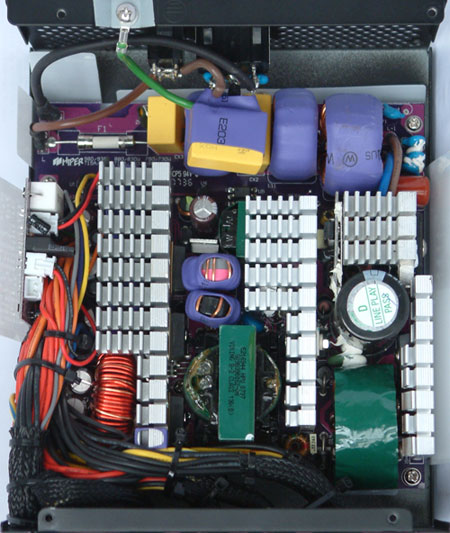
The inside of the Hiper unit looks very similar to a well-known manufacturer. We won't name names, as Hiper made many changes to the internal design. There are several smaller heatsinks inside; the secondary heatsink remains as a single unit, while the primary is made up of three smaller heatsinks that cool different components like rectifier bridges and diodes.
OCZ ModXStream - 780W
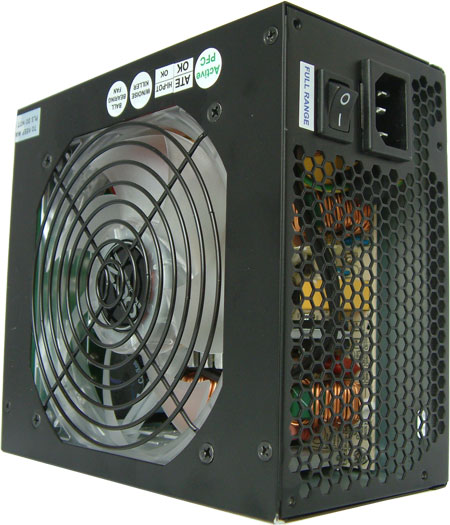
OCZ sent their ModXStream 780W power supply. It has modular cables to help with cable management. The housing comes in black and as the picture shows fingerprints are easily visible. The exhaust at the back is quite open and allows for good airflow. The 120mm fan is installed on the bottom of the unit. Everything comes packed in a very small box, with the standard accessories like screws, a power cord, and the user manual.
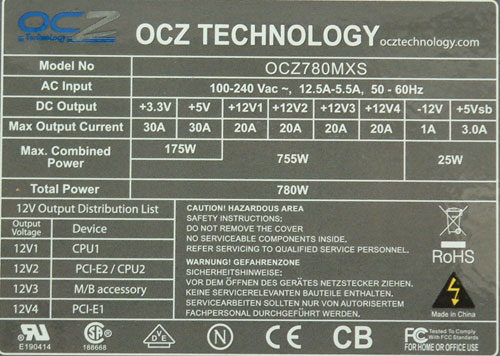
The label shows 20A for each of the four 12V rails and a combined power of up to 755W. As we saw on the Amacrox power supply, the ModXStream also contains a table with 12V distributions for the different connectors. OCZ made some changes here and places one ATX connector on 12V1; a PCI-E connector and the second CPU rail are on 12V2. The peripherals are on 12V3, and the main graphics card gets 12V4.
Cables and Connectors
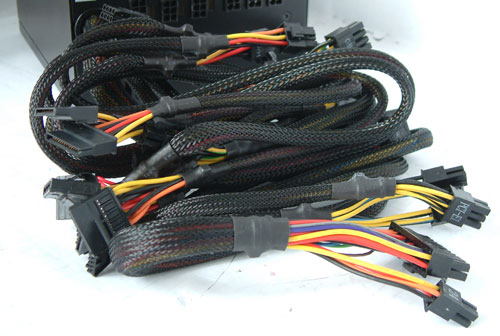
All the cables are sleeved and the cable management system allows the user to detach cables that aren't needed. The sockets on the PSU have different pin-outs so the user can't attach the harnesses to the wrong jack. Like the 730W/770W Hiper, the ModXStream is a little short on connectors for a 780W unit. It only has four Molex and six SATA connectors.
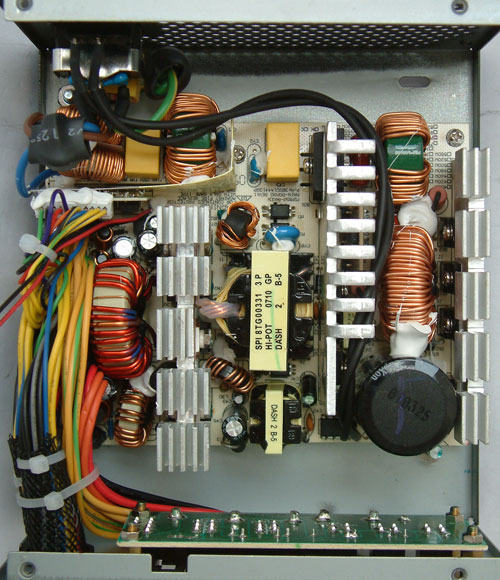
The internals are nice and clean, like we saw on another unit. The ModXStream looks a little empty inside because of the enormous housing length; the extra length is unnecessary and actually makes the ModXStream unable to fit in certain cases. There's also enough space on the sides for eddies to occur in the airflow. The temperature results of the heatsinks during testing confirm this, as we measured up to 90°C at the middle heatsink. With a 50°C exhaust temperature, clearly the airflow isn't working properly.
Seasonic X900 - 900W
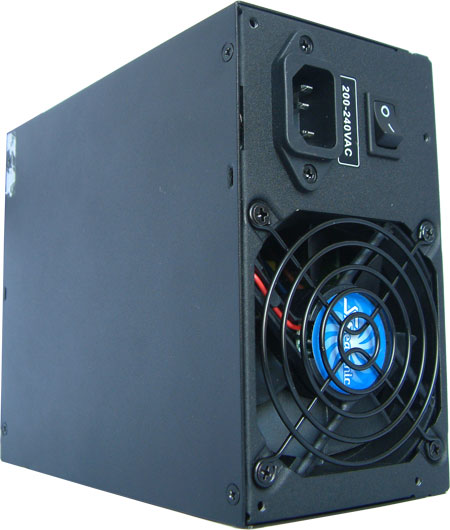
What a beauty Seasonic has here! Unfortunately, it's not even available in the United States. As we stated before, the US market doesn't need to be too sad since we will see the same power supply under a different name. Still, it's funny to see a little sticker showing 200-240VAC on the back suggesting this power supply should only be used in Europe. We have tested this unit on 90VAC and 120VAC without problems, so you can ignore the misleading sticker. Of course, Seasonic probably has reasons for these actions.
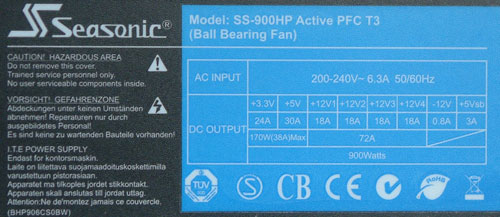
Four times 18A for the 12V rails is good. With a combined power of 72A, the 12V rails can almost reach the rated 900W on their own.
Cables and Connectors
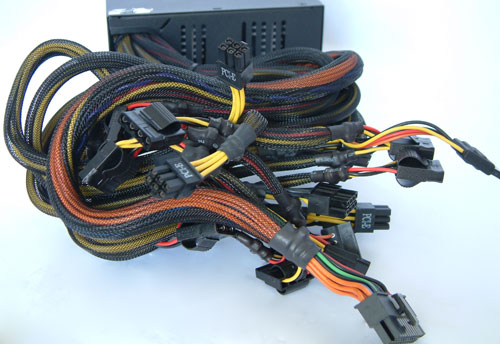
This power supply also has the cables sleeved with black mesh. The cables are quite short, which is surprising for a high-end unit that will likely be used in a bigger case. Apparently, Seasonic feels differently, and they have attached many harnesses with lengths of 25cm to 65cm. The amount of connectors is good and the lengths will work well in smaller cases; then again, smaller cases probably don't need this many connectors.
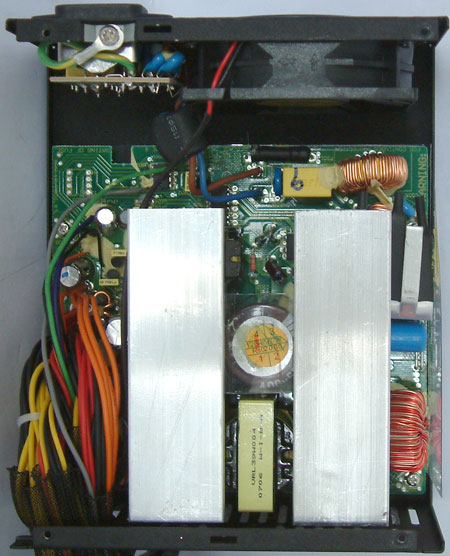
Opening the unit, we find a unique and sleek design which is made for cooling by a single 80mm fan. The heatsinks are T-shaped and only allow for horizontal airflow. Comparing this unit to the nice 750W red one from before, there are several added components that help it reach the higher performance rating. Again, we see a high-quality Nippon Chemi-Con cap in the primary. The temperature of the heatsinks is been also very good, but this is due largely to a very annoying fan.
Silverstone OP850 - 850W
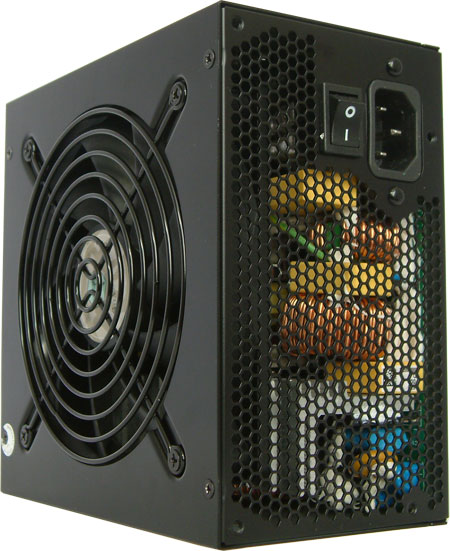
We have seen already two other versions of this unit before in the 650W class. The 850W version doesn't differ too much, and from the outside it looks the same. On the inside, however, there are plenty of changes, including a new topology. The power supply comes in a black housing with a large 120mm fan.
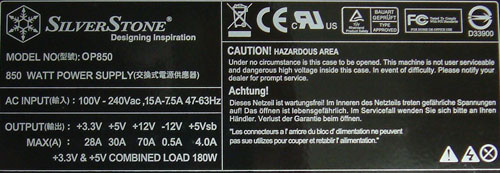
As we have seen before the OP850 has just a single 12V rail which supports up to 70A.
Cables and Connectors
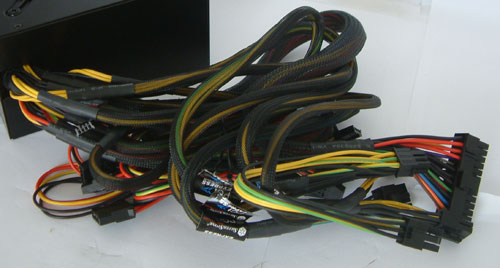
All the cables are sleeved as usual. The mesh starts outside of the power supply which is not as attractive. If a company pays for the additional costs of adding sleeves, they should do the job correctly and start the mesh inside the power supply chassis. Other than aesthetics, though, there's no disadvantage in this approach. The cable harnesses are very long and have a maximum length of 110cm for the floppy connectors and 100cm for the Molex connectors. There are six Molex and SATA connectors, which is enough though a few more wouldn't have hurt.
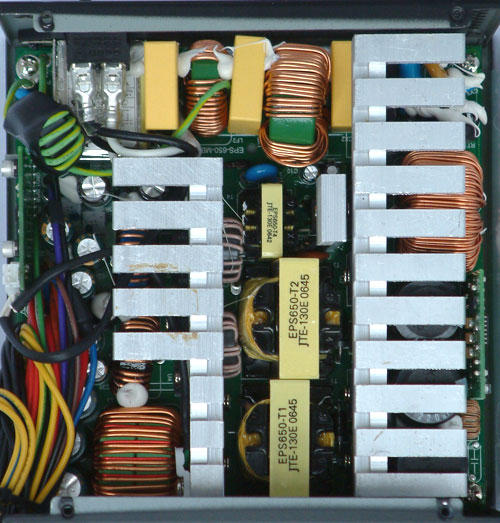
The inside is nicely arranged and makes a good impression. There are two large heatsinks that reach from front to back. The fins are thick and should provide ample cooling. However, our measurement of up to 90°C in the heat-chamber is quite high. With an exhaust temperature of just 58°C, it appears the airflow isn't removing heat from the heatsinks. Instead, heat builds up inside the housing, which is not the intended result. Still, the power supply did complete our tests and we couldn't find any major problems.







